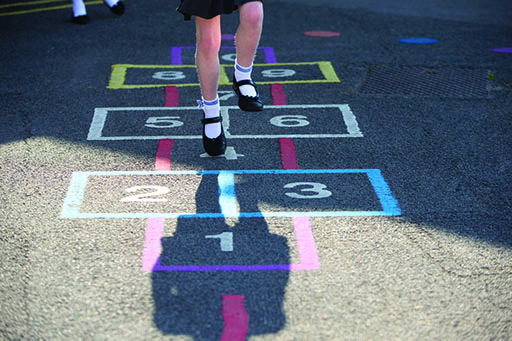2.1.2 Physical activity play
The children were asked to draw themselves in the school playground. Not surprisingly, perhaps, almost all of them drew themselves engaging in some sort of activity. These accounts are fairly representative:
I’ve drawn some hopscotch and I’m going to draw some people queuing up behind the tent because they’re going to do it backwards because I can’t just start here and draw all the people here so everyone’s going to be there and in the sandbox people are digging and putting the sand into the buckets, but I didn’t get to draw that … So here is going to be me hula-hooping and then I’m going to have the sun here and I’m going to have two butterflies flying and then I’m going to have Thelma skipping and then when I go into the garden I’m going to draw collected plants and things that have fallen on the floor.
This one was holding a rope and it went around when it came to you, you jumped over it but these are all the people. This is Gary who’s running away. He’s going to jump over the rope when it came.
The children’s accounts of physical activity play generally took one of two forms: creative and locomotor play. The first type of play involved imagination and the creation of characters: ‘Maybe spies or something, and policemen’ (Y1 boy). In one discussion, two boys were asked who they liked to be when they were pretending:
M: Policemen. T: Soldier, one two three four, one two three four. M: Firemen.
Locomotor play was much more frequently cited, however, especially by the boys. Younger children talked about hula hoops, hopscotch and climbing frames. And children of all ages spoke about the joys of running and chasing, such as this Year 4 girl: ‘And also I like the playground when some people are chasing after Pete the TA and then there’s most of the playground free to just walk around’. However, by far the most frequently discussed form of playground activity amongst this group of children was football:
Ok, I’m playing football. I scored a goal. When I finished football Oliver locked Christian in the door. I came back to play another game of football and then I scored another goal and then after that game of football we went to line up.
Only a few children used ‘fun’ to explain their reasons for playing: ‘I like skipping because it’s fun’ (Y1 girl), and only one other child spoke of values intrinsic to an activity when asked why they played such games: ‘What I like about football is – I don’t know – scoring goals’ (Y2 boy). Everyone else spoke in rather instrumental ways about the benefits of activity. Health was the dominant discourse underlying the children’s rationales for playing physically active games. For example, these comments were representative of numerous other statements:
Well it’s because then we can take equipment outside and play sports so we can be healthy.
So not just running around, we can run, climb on things – cause climbing is a very exercises thing. Like if you climb high, if you go fast that will be very good because it’s exercise thing.

